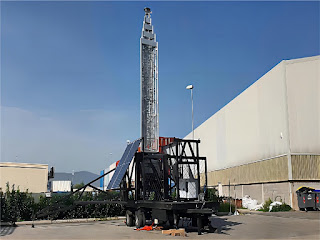Advantages of Cell on Wheels Units Comparing to Regular Telecom Towers
Cell on Wheels (COW) units offer several advantages compared to traditional telecom towers, especially in temporary or rapidly changing situations. Here are some key advantages of COW units:
1. Mobility and Rapid Deployment: COW units are designed to be easily transported and quickly deployed to areas where additional mobile coverage is needed. They can be mounted on trailers or trucks, allowing for flexibility in their placement. This mobility is particularly valuable in emergency situations, special events, or during network upgrades or maintenance.
2. Temporary Coverage and Scalability: COW units provide temporary coverage in areas where there is a need for additional capacity or where permanent infrastructure is unavailable or impractical to install. They can be rapidly deployed and removed as needed, making them ideal for short-term events or situations that require temporary expansion of network capacity. Additionally, COW units can be easily scaled up or down to meet changing demands.
3. Cost-Effectiveness: Deploying traditional telecom towers can be time-consuming and costly due to the need for site acquisition, permits, and construction. In contrast, COW units offer a more cost-effective solution, as they eliminate or minimize these upfront expenses. They provide a temporary coverage solution without the need for significant infrastructure investments.
4. Flexibility in Coverage Areas: COW units can be deployed in remote or underserved areas where permanent tower installation may not be feasible or economically viable. They can quickly fill coverage gaps, provide temporary coverage in disaster-stricken regions, or support large events where a sudden influx of users requires additional network capacity.
5. Relocation and Shared Usage: COW units can be relocated easily to different areas as coverage needs change. This allows for efficient utilization of resources by sharing COW units among multiple locations or operators, reducing redundancy and optimizing coverage in various areas.
6. Minimal Environmental Impact: Compared to permanent telecom towers, COW units typically have a smaller footprint and less environmental impact. They require minimal infrastructure modifications and can be set up without disrupting the natural landscape or architectural aesthetics.
It's important to note that COW units also have some limitations. They generally provide lower capacity and coverage compared to permanent towers, as they are designed for temporary or emergency use. Additionally, the mobility and temporary nature of COW units may introduce logistical challenges, such as power supply and connectivity. However, their advantages in terms of rapid deployment, temporary coverage, cost-effectiveness, and flexibility make them a valuable solution in various scenarios.
Cell on Wheel units can also be deployed in urban areas. Here are some key advantages of COW units:
1. Mobility and Rapid Deployment: COW units are designed to be easily transported and quickly deployed to areas where additional mobile coverage is needed. They can be mounted on trailers or trucks, allowing for flexibility in their placement. This mobility is particularly valuable in emergency situations, special events, or during network upgrades or maintenance.
2. Temporary Coverage and Scalability: COW units provide temporary coverage in areas where there is a need for additional capacity or where permanent infrastructure is unavailable or impractical to install. They can be rapidly deployed and removed as needed, making them ideal for short-term events or situations that require temporary expansion of network capacity. Additionally, COW units can be easily scaled up or down to meet changing demands.
3. Cost-Effectiveness: Deploying traditional telecom towers can be time-consuming and costly due to the need for site acquisition, permits, and construction. In contrast, COW units offer a more cost-effective solution, as they eliminate or minimize these upfront expenses. They provide a temporary coverage solution without the need for significant infrastructure investments.
4. Flexibility in Coverage Areas: COW units can be deployed in remote or underserved areas where permanent tower installation may not be feasible or economically viable. They can quickly fill coverage gaps, provide temporary coverage in disaster-stricken regions, or support large events where a sudden influx of users requires additional network capacity.
5. Relocation and Shared Usage: COW units can be relocated easily to different areas as coverage needs change. This allows for efficient utilization of resources by sharing COW units among multiple locations or operators, reducing redundancy and optimizing coverage in various areas.
6. Minimal Environmental Impact: Compared to permanent telecom towers, COW units typically have a smaller footprint and less environmental impact. They require minimal infrastructure modifications and can be set up without disrupting the natural landscape or architectural aesthetics.
It's important to note that COW units also have some limitations. They generally provide lower capacity and coverage compared to permanent towers, as they are designed for temporary or emergency use. Additionally, the mobility and temporary nature of COW units may introduce logistical challenges, such as power supply and connectivity. However, their advantages in terms of rapid deployment, temporary coverage, cost-effectiveness, and flexibility make them a valuable solution in various scenarios.


.jpg)
评论
发表评论